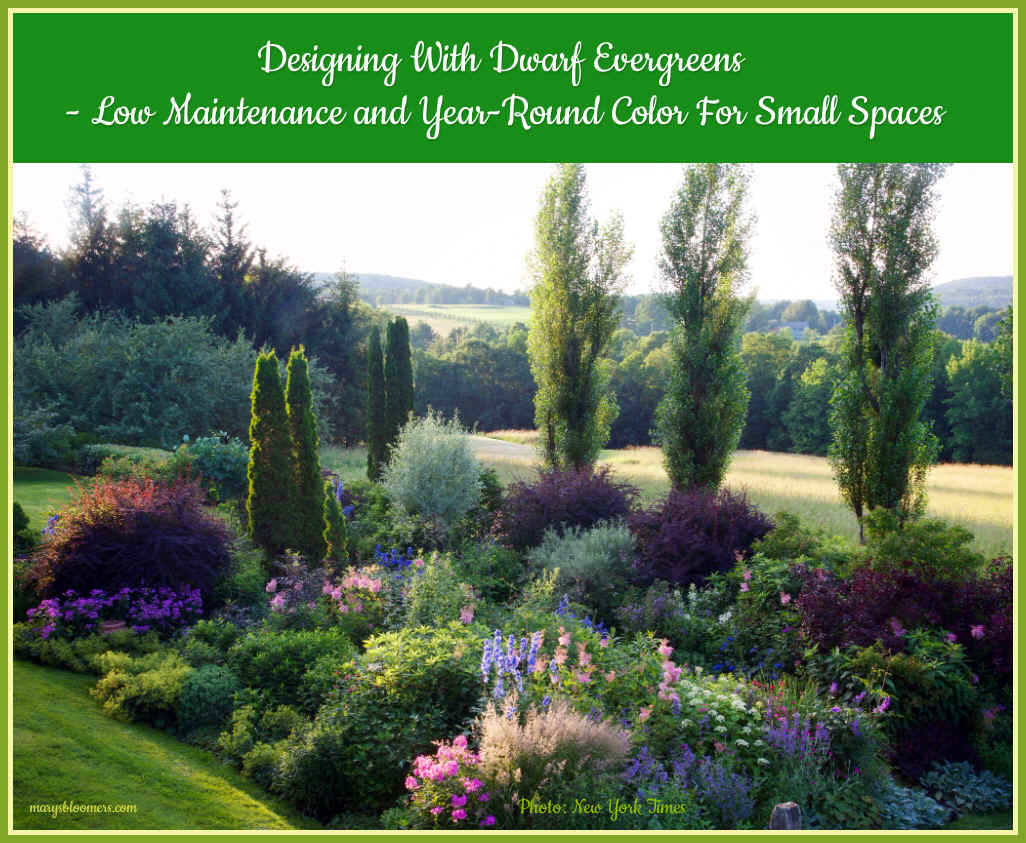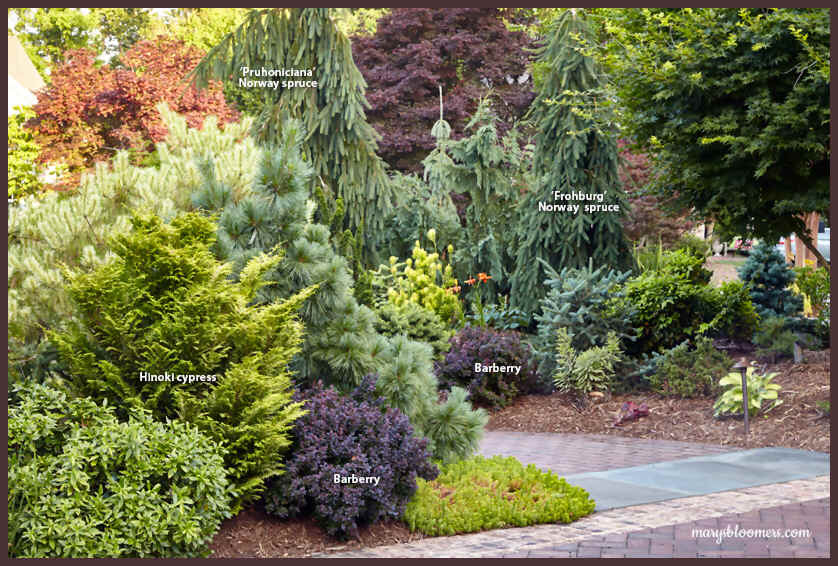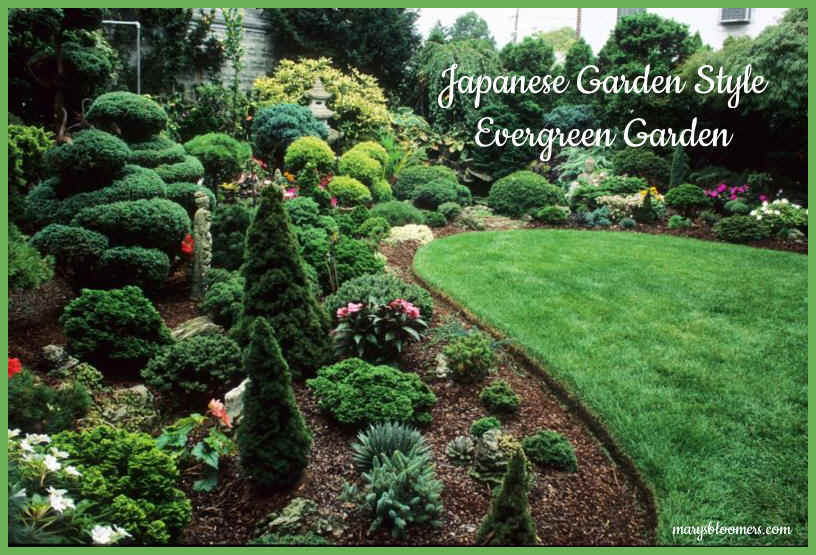Evergreens are excellent,
non-fussy plants that provide your gardens with year-round color, and
give food and
shelter to birds and wildlife.
There are thousands of types of
evergreen shrubs, trees and ornamentals, in every size and shape. Some varieties tolerate
extreme heat and cold, so be sure to read the plant labels at your
nursery to find one that's suited to your USDA
hardiness zone. I recommend dwarfs in the small-space, urban or
specialty-theme gardens. There are several evergreen ornamental
grasses and flowering plants that can be grown together for a
beautiful effect. Dwarfs have a "personality". Much less
boring than that of their bigger relatives.
I do not like a lot of plain green
in my garden, so i shy away from many evergreens. I would never plant
a privet or boxwood hedge. No sir. But if the plants have a nice shape
and variegations, and stay that way all winter, I'll give them space
in my gardens. The right combinations, along with flowering ornamental
evergreens, is stunning.
Use dwarf conifers to dress up
an existing planting of evergreens. Dwarf and intermediate conifers
can add color, form, and texture to an otherwise monotonous row of tall conifers.
Lovely when combined with flowering plants.
They look great year- round, come
in all kinds of shapes, forms, and colors, many are water-wise once
established, and most thrive in extreme climates. But the real
reason to like them is the way they provide strong structure and
play well with flowering plants during the growing season, and a
garden focus during the winter. Conifers provide important shelter and food for birds and
many small animals who live within them during the coldest months.
The types.....
Arborvitae - Members of The
Cypress Family of Conifers
American arborvitae
(Thuja occidentalis) is a hardy, native evergreen with a
narrow pyramid shape. Dwarfs and miniatures make
great accent plants or foundation plantings. They go great with
blooming evergreen shrubs. The height and slim shapes look stunning in an
evergreen garden design, and as centerpieces or focal points in any
theme garden design. Awesome in pots, too. The tree is dense, with a
pyramid shape,
and clusters of little cones. Dwarfs include
Golden Globe, Hetz Midget and Tiny Tim.
Other names for arborvitae include
northern white-cedar, eastern white-cedar, and swamp-cedar. Native
Americans made baskets from the roots, and used the leaves in tea.
The wood is used for log cabins, fenceposts, shingles, paneling,
canoes, and wood crafting.
How to Plant Arborvitae
Plant in early spring
when the soil can be worked, or in the fall before the ground freezes.
Choose a location in full
sun or partial shade.
Amend the soil by digging
in about 2 inches of compost or aged manure.
Dig the planting hole 2
to 3 times as wide and as deep as the root ball.
Loosen some of the roots
in the root ball.
Plant the arborvitae in
the hole so that the top edge of the root ball is level with
the top of the hole.
Back-fill with soil
around the root ball, tamping down with your hands.
Soak the soil in the hole
when you have filled it ½ full.
Finish filling to the top
edge of the root ball.
Water deeply.
Add a 2-inch layer of mulch
to conserve moisture.
How to Grow Arborvitae
Keep the soil consistently
moist the first growing season. Don’t let the soil dry out but
be careful not to over-water.
Established arborvitae will
require extra water only during prolonged periods of drought.
Use stakes for support as newly
planted arborvitaes are vulnerable to wind.
Fertilize the arborvitae in the
spring with a slow-release high-nitrogen shrub/tree fertilizer. How to Prune
Plants that are used in formal
hedges and foundation plantings can be trimmed with hedge shears
to shape and to spur new growth.
Prune in early spring before
new growth emerges. Trim from the bottom up.
Shorten branches that are
expanding beyond the desired length. Prune damaged branches anytime.
Recommended
Dwarf Arborvitae
‘Hetz Midget’
is a hardy dwarf that reaches 3 to 4 feet tall. Its naturally
round form makes it ideal for foundation plantings.
‘Tom Thumb’
is a miniature and grows only 12 to 15 inches tall. It is a dense
multi-stemmed shrub with a rounded form, perfect for containers or
rock gardens.
Conifer is an
evergreen tree or shrub that bears cones and needle-like leaves.
The arborvitae explained above, is a genus of conifer, nicknamed
"tree of life"
Most dwarf conifers like sunny,
well-drained sites with slightly acidic soil. If your site does not
match these characteristics, there are dwarf conifers for other
conditions as well.
When you're planning your garden,
don't forget to pay attention to how tall and wide the plant
gets at maturity, especially if you're considering a fast-growing shrub. That cute
little shrub won't stay tiny forever, and you don't want to prune it
several times a year. Many new varieties of shrubs have been developed in
recent years to stay nice and compact, so that they can fit up against
your house as a foundation planting, or in pots on either side of your
front door, or on deck or patio steps.
Dwarf conifers usually don’t get
taller than 1 to 6 feet in 10 years. Fortunately, the small size and
slow-growth habit of dwarf conifers make them easier to transplant
than some other woody plants.
Miniature conifers (which are tiny
dwarfs) grow no more than 12 to 15 inches high and are perfect
for containers, rock gardens and as perennial bed accents. Drought
tolerant cultivars do best in containers and rock garden, because
they can go long periods without water. erfect in a xeriscape. Miniatures in containers can
remain outside during winter, even in the north.
According to the American Conifer
Society, a dwarf conifer will grow between 1 inch to 6 inches per year
while a miniature will grow less than 1 inch per year. Feeding is
discouraged. Less nutrients keep dwarfs small. Their roots will
search the soil for enough nitrogen and other elements to keep the
trees healthy.
Dwarf conifers can be used to
control erosion and eliminate the need to mow on a steep slope.
Combined with a few weed-suppressing ground covers, a planting of
several dwarf conifers is an attractive and low-maintenance
design solution. You can stick them in just about anywhere.
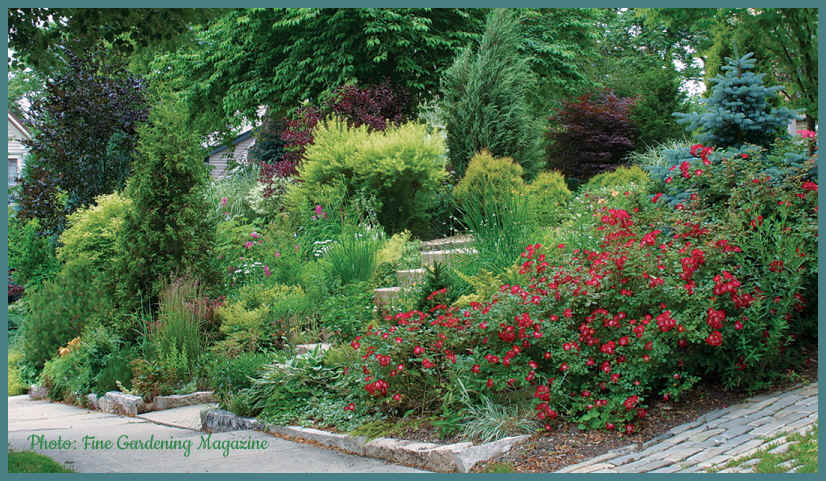
A dwarf conifer with either a
vertical, narrow habit, or a pyramidal form, can add height to a
combination, serve as a focal point, or add a sense of depth to a
small or narrow bed. Good candidates for this type of design include
upright and narrow arborvitae, false cypresses, and junipers.
Pyramidal candidates include dwarf Alberta spruce and ‘Technito’
arborvitae (Thuja occidentalis ‘Technito’, Zones
3–7), a recently introduced smaller version of ‘Techny’
arborvitae.
Care of Dwarfs is the same as
care for any conifer.
- Water them when dry during
the first year. In following years, they should be fine
without supplemental water.
- Fertilizer is not needed.
- Spruces and firs may be
attacked by mites. Bagworms target false cypresses. Fungal
diseases might affect pines.
Once planted in your garden,
some dwarf conifers may mutate or revert to the original,
fast-growing species. Watch for shoots differing from the rest of
the plant—faster growing or a different color or texture—and
remove them as soon as you see them.
Creating
A High Point
In addition to the
low-growing, spreading types, other dwarf conifers are
more upright and add vertical punctuation to a small
landscape. These are especially useful in larger borders,
but also to add height and also soften the corner of a
house, frame a pergola, arch, or water feature.
Groundcover
Tough and unbothered by moderate foot traffic, spreading
varieties of dwarf conifers are excellent groundcovers.
Allowed to spread, and scramble,
they’ll be some of easiest options for softening spaces.
Potted
One of the easiest ways
to use dwarf conifers is in containers. Conifers aren’t
picky, but they like well-drained soil.
Picks For Small Spaces and Urban Gardens
Sawara cypress (Chamaecyparis
pisifera, Zones 4 to 8)
Good for a small landscape
include Filifera Aurea, with golden-yellow foliage and Golden
Mop, a low and mounding variety with threadlike foliage. You
can find dwarf varieties in all kinds of shapes and sizes,
including shades of green, blue, yellow, white and variegated.
Hiba arborvitae
(Thujopsis dolobrata species and
cultivars, Zones 5 to 7)
A native of Japan, this conifer has
large, broad branches with glossy leaves. It’s often used
for hedging and is a versatile backyard plant. It’s not as
common as other conifers. The compact form is "Nana. It
tolerates a wide range of soils and does best in partial
shade.
Dwarf Colorado blue
spruce
(Zones 3 to 7)
Prefers rich, moist soils and full
sun, though it is more drought-tolerant and adaptable than
other spruces. "Montgomery" is a compact dwarf blue
conifer.
Oriental spruce
(Picea
orientalis species, Zones 4 to 7)
The needles are glossy green and
soft to the touch. For smaller gardens, look for slow-growing
cultivars like Nana (usually stays under 3 feet high), or Tom
Thumb, with golden foliage. It will tolerate some shade,
drought and wind.
Creeping juniper
(Juniperus
horizontalis species, Zones 4 to 9)
American
native grows well in just about any soil, and is a popular
choice for mountain slopes and seashores. Like other
junipers, it prefers full sun and good drainage.
Japanese
Holly
With small, rounded leaves and
many interesting forms, Japanese holly boasts a strong
architectural form. Interesting needles and showy
cones.
Mugo Pine
This hardy pine works
beautifully in rock gardens, mass plantings, and mixed with other
broadleaf plants. Colors range from deep green to gold.
Mahonia
This low-care shrub has bright
flowers that appear in late winter to early spring and become blue
to black berries by late summer to fall. It’s perfect in mass
plantings.
Blues and
Silvers
Silvery-blue
conifers are beautiful when planted in bold masses or in drifts.
Dwarf
Scotch Pine
Useful form with
rich blue-green needles on dense, horizontal branches.
Takes well to pruning and shaping. Slow, up to 6 ft.
tall and wide. Zone: 2 – 7
Low-growing Colorado spruce (Picea
pungens ‘Glauca Pendula’, (Hardiness Zones 3-8) grows
3 or 4 inches a year, eventually spreading to about 8 feet wide and
4 feet tall, with silvery needles
Dwarf Korean fir (Abies
koreana ‘Silberlocke’, Zones 5-6) slowly becomes a small
tree and has strongly curved needles that turn the entire plant
silver. Grows 2 to 4 inches per year and
get 4 to 5 feet tall and around 3 feet wide.
Montgomery spruce (Picea
pungens ‘Montgomery’, Zones 3-8) is a short, squat spruce
that grows 3 to 4 inches a year and can eventually reach 6 feet tall
and 8 feet wide.
Thujopsis dolabrata
(Zones 5-7) Its green foliage has bright silvery bands
underneath. This one does best in light shade. It has a
Christmas-tree shape and grows 4 to 8 inches a year. It probably
won’t get any taller than 10 feet, and 5 ft. wide.
Dwarf
Globe Blue Spruce
Prized for it’s
bright-blue foliage that holds its color all winter.
Globe-shaped and densely branched. Slow, eventually
reaching up 5 ft. tall, 6 ft. wide. Zone: 2 – 8
Dwarf
Blue Rocky Mountain Fir
Striking blue,
soft needles; grows into a dense, pyramidal form.
Slow, up to 4 ft. tall in 10 years; eventually up to 8
ft. tall, 6 ft. wide. Zone: 3 – 7
Blue
Angel White Pine
Uniform and
densely-branched upright form with brighter, silvery
blue-green needles. Slow, uniform shrub or small tree
7 to 8 ft. tall, 3 to 4 ft. wide. Zone: 4 – 9
Weeping
Blue Atlas Cedar

Dramatic, weeping
habit with a sprawling horizontal form; often trained
into upright, serpentine form. Slow, spreading up to
20 ft. wide. Zone: 6 – 9. I had one of these in a
southern garden, and it was a beautiful focal point.
and the star of my xeriscape.
It would be excellent in a zen
or Japanese theme garden.
When I say it grows slow, i mean it. I noticed barely
any height growth per year, but i did notice lots of
new green needles that mature to the blue-green color.
Stunning in an Asian-style planter or container as a
focal point..
Cedar
These evergreens have a
striking form and elegant blue-green foliage. Some grow quite
tall, so read the plant description before buying.
Mellow Yellows
Most yellow conifers will turn
green in the shade, so place them where they will receive full
sunlight. Some may burn in hot, dry
locations, so they prefer light shade in those conditions.
Standish yew is a dwarf (Taxus
baccata ‘Standishii’, Zones 7-8), a slow-growing column
(1 to 3 inches per year) that never becomes much larger than 4 feet
tall and 18 inches wide. Serves as an
evergreen accent in a perennial border. It has normal yew foliage
with yellow highlights on the tips. The more sun you give it, the yellower it gets.
Golden Mounded Hinoki false
cypress (Chamaecyparis obtusa ‘Nana Aurea’ and ‘Nana
Lutea’, (Zones 5-8) have tight, cupped foliage in addition to their golden color. Both grow less than 2
inches a year ,and will eventually become 6 feet tall and 3 feet
wide.
Fire
Chief™ Globe Arborvitae
Globe-shaped
with golden, spring foliage and deep-red fall
color. Slow, reaches up to 2 ft. tall and wide in 10
years; 4 ft. at maturity. Zone: 5 – 8
Greens are not just green....
Dark-green and densely branched
dwarf Hinoki false cypress (Chamaecyparis obtusa ‘Nana
Gracilis’, Zones 4-8) grows equally well in sun or shade (2
or 3 inches per year).
In sun or shade, and being
ignored by deer, prostrate plum yew (Cephalotaxus
harringtoniana ‘Prostrata’, Zones 6-9). This dark-green
shrub acts like a ground cover.
Chartreuse new growth in the
spring, which contrasts with the dark green of the older leaves.
‘Duke Gardens’ holds its shoots more upright. With a
growth rate of 3 to 6 inches per year, it will spread to a width of
5 feet and a height of 2 feet. It will grow under deep-rooted trees.
Slowmound
Mugo Pine
Rugged,
water-wise, with finely textured, deep green foliage;
seldom needs pruning. Slow, reaches up to 2 ft.
tall and wide in 10 year; to 3 ft. at maturity. Zone:
2 – 8
Tiny
Tower® Dwarf Alberta Spruce
Pyramidal form,
perfect for smaller gardens. Foliage matures to an
attractive gray-green. Slow, reaches up to 6 ft.
tall, 2 ft. wide. Zone: 3 – 8
Miniature
Moss False Cypress
Dwarf
evergreen globe-shaped
form and bright-green foliage. Slow reaches up to
30 in. tall and wide. Zone: 4 – 8
Danica
Arborvitae
Versatile, dwarf,
globe-shaped with bright emerald green foliage that
turns bluish- green in winter. Moderate reaches
up to 2 ft. tall and wide. Zone: 4 – 8
Dwarf
Japanese Garden Juniper
Prime
specimen of dense, water-wise groundcover. Winter color has a
purple tint. Reaches up to 1 ft. tall, 6 ft.
wide. Zone: 4 –9. I grow these as an accent
ground cover in raised bed plantings in my Zen
Garden. Takes well to shearing.
Hemlock
Dense branching
and finely textured foliage make this shrub a winner as a specimen
or planted in a mass to create an interesting screen. Most
tolerate some shade. Graceful with cute little cones.
Inkberry
Holly
Upright branches
and a mostly round shape
Arborvitae,
Pyramidal Form
These pyramidal forms
come in
many different heights, ranging from a few feet to 30 feet tall or
more. Holds its shape without shearing. Hardy
and fast-growing. Very pretty focal points, adding height and
shape in flower beds.
Arborvitae,
Round Form - Dwarf
Adorable and stay in the 12 to
24-inch-tall range, so you can tuck them just about anywhere in
the landscape. And they’re super tough in cold climates.
Caring
for Conifers
-Prefer slightly
acidic soil.
-Most are not
fussy about type of soil, but they do not like
sitting in wet soils.
-Fall is the
best time to plant. But I have planted them from
spring til fall with no problems.
-Prune as
needed.
Evergreen
Ornamental Grasses and Flowering Plants
Azalea
These shrubs with glossy green
leaves put on a show in early spring. Be sure to purchase an
evergreen (not a deciduous) variety if you want it to to be
evergreen and not lose its leaves in winter. Likes the shade.
Rhododendron
Grow it in full
sun to partial shade zones 5-8
"Elijah
Blue" Fescue (festuca) - Evergreen Ornamental Grass
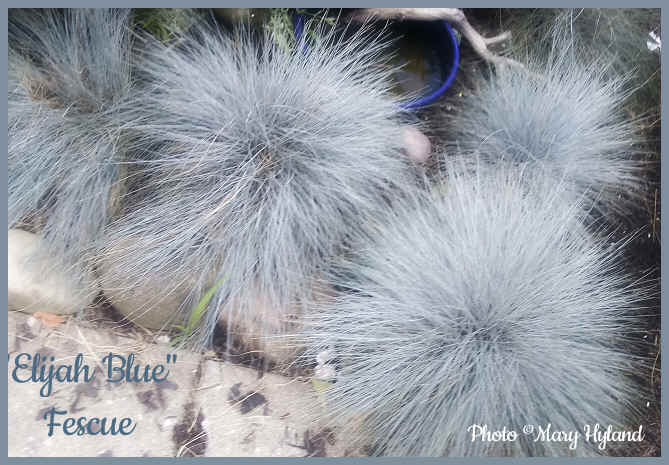
Adorable, neat, rounded blue-green mounds, zero maintenance.
Grow to about 1 ft. tall. Looks beautiful in the snow and as part
of an evergreen garden theme. Totally evergreen and the color
stays beautiful. It likes water in hot, dry spells, but otherwise,
it can take anything. No pests or disease. I highly recommend them
for the front of flower beds, sidewalk edgings, foundations, on
slopes, and in pots. Keeps weeds out. Weeds don't grow under them.
Wheat-type stems pop up in summer. They can be left on or cut off.
I do both, depending upon the design of
the
area they're in. I trim them off along my frontyard path, because
they like to hang over. In the photo, they seem to have a glow.
They really do shimmer with a silver shade in the bright sunshine.
Evergreen gardens
are beautiful and low-maintenance. Worth a spot in your gardens.
Sources:
Old Farmer's Almanac
Birds and Blooms, Monrovia
Fine Gardening
Better Homes and Gardens
Country Living
New York Times
Recommended
Reading and Dwarf Conifer Nursery Stock
Lots of what I
grow and how i grow them are available from nurseries and
landscape suppliers
on Amazon. My supplies are quite heavy, so the free shipping makes me smile.
Not to mention
not having to go out and get the stuff, then drag it home. I am the World's
Laziest Gardener.
|
